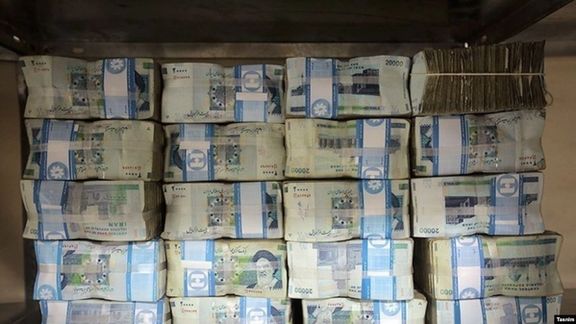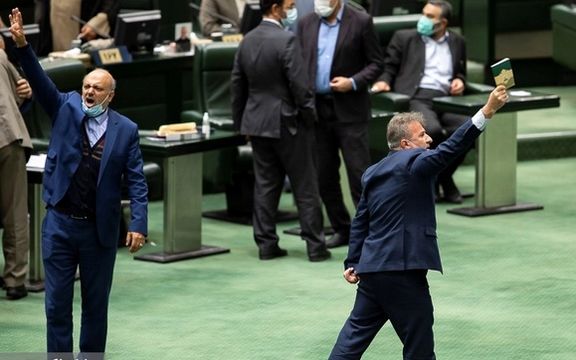Iran's Currency Drops To Lowest Point In A Year As Nuclear Talks Approach

Iran’s currency Wednesday fell to its lowest point in a year as US sanctions continued and prospects for reaching a deal in nuclear talks with the West deemed.

Iran’s currency Wednesday fell to its lowest point in a year as US sanctions continued and prospects for reaching a deal in nuclear talks with the West deemed.
The currency, rial, dropped to 290,000 against the US dollar in Tehran’s exchange market, raising fears of more inflation in the near future. Iran already suffers from more than 60 percent rise in food prices in the past one year, as a cash-strapped government prints money, inflating liquidity.
The rial has dropped more than ninefold since early 2018, when former US president Donald Trump signaled his intention to withdraw from the 2015 nuclear agreement with Iran, known as JCPOA. Trump carried out his threat in May 2018 and imposed crippling sanctions on Tehran’s oil exports and international banking.
Indirect nuclear talks with the United States are scheduled to resume next week in Vienna, but a tougher position adopted by the new hardline government in Tehran has led to pessimism over chances of a successful outcome.
In the past four years, the deepening economic crisis has led to large protests in which security forces killed hundreds of protesters. With a parallel water shortage and pollution, rising prices pose a serious risk of renewed unrest against the government.

Revelations about "astronomical" salaries for some state company managers amid high inflation and rising poverty in Iran have led to calls for transparency.
Investigative reports in the media and posts on social media have shown what Iranian’s call “astronomical salaries” that politically appointed managers earn in loss-making state industries.
It is still not known if these are genuine investigative reports or if journalists and social media influencers have been tipped by rival factions and clans within the Iranian government.
On November 23, the IRGC-linked daily newspaper Javan ran a front-page report that said monthly salaries higher than 2.15 billion rials paid to some government managers is an outcome of lack of transparency in government operations. The amount mentioned would equal roughly to $51,000 based on the government’s preferential exchange rate and $9,000 based on the free market rate. But even at the lower dollar equivalency, it is an astronomical amount by Iran’s standards.
Ordinary wage earners make about $100 a month and office workers and teachers less than $200.
Meanwhile in a separate story, Javan quoted Majles Speaker Mohammad Bagher Ghalibaf as saying that "first the parliament and then the rest of government institutions in Iran are going to make their operations transparent." The Iranian Parliament (Majles) has been under immense pressure from the media and the public to reveal the voting record of lawmakers. However, hardline clerics at the Majles have so far strongly resisted transparency and argue that "enemies" might benefit from the information.
Scores of social media accounts on Telegram and Twitter have revealed high salaries are being paid to some government managers. The proreform Telegram channel @Maktubat, which has over 24,000 subscribers, on November 22 posted the payslip of one of the managers of the government-owned Amir Kabir Petrochemical Plant, showing that was receiving 2.15 billion rials per month. The channel said this was equal to an ordinary government workers’ wage for four years.
Meanwhile, hardline commentator Hassan Rahimpour Azqadi posted three payslips from the same company on his Twitter account and showed the company's CEO received 2.15 billion rials, its HR Chief received 1.25 billion and the company's Security Chief received 840 million rials per month.
In another post, hardline journalist Mehdi Khalili published some more documents comparing salaries and cost of living in Iran and addressed President Ebrahim Raisi saying, "Look at the payslips and compare them with what teachers and other workers living under the poverty line earn. Where are you Mr. Raisi. You have been in office as Iran's President for more than 100 days and still, there is such an injustice done your employees."
In an elaborate attempt to distance Supreme Leader Ali Khamenei from government mismanagement and financial corruption, Javan has concluded in its report that after years of complaints by the people and warnings by the Supreme Leader, apparently the only solution for financial corruption appears to be transparency. Meanwhile, the daily warned that false transparency will only make matters worse.
User comments about the matter on social media were interesting particularly on Telegram where they feel safer and at times come up with radical comments. One Telegram user responded to the vast difference between income of government employees, "This is no longer a class difference. This shows a wide gap between classes." Another user said, "Soon we will be seeing a revolt by the poor."
On Twitter, one user who responded to Azqadi's call for an explanation by the President, wrote: "They will not offer any explanations, but you are going to see a lot of justifications." And another user reminded that the company security chief who receives 840 million rials per month will turn a blind eye to whatever corruption that takes place in the company.

Child marriage has risen over 30 percent in Iran this year from the same period last year, with 9,750 girls aged 10-14 officially wed in a three-month period.
Figures published by Iran Statistical Center (ISC) relating to the first three months of the Iranian calendar year (March 21-June 20 2021), are the highest for child marriages recorded in a single quarter.
The Iranian Student News Agency (ISNA) in a detailed article Monday said that the numbers published by ISC reflected only registered marriages and not unregistered ones, which are common in rural areas.
Over 54,500 teenage girls above 14 also were officially married. Marriages of boys under 18 − considered ‘underage’ internationally − were far fewer, with only six cases registered for boys under 15 and 6,500 for males between 15-19.
For years the issue of underage marriage has been debated in Iran, with many clerics and religious politicians defending marriages of girls under 15. Proposed legislation to forbid marriage in for girls under 14 has been pursued unsuccessfully even in relatively more reform-minded parliaments.
Fathers are required in law to agree to the marriage of daughters younger than 13, while a religious court must also certify that the girl is ready physically and mentally, and that she agrees to the marriage. ISNA claimed that judges often seek only the father’s consent and disregard the other requirements.
One major reason for the rise in underage marriages is the current economic crisis where poor families struggling to take care of children see early marriage as a better option. There is a government cash grant of around $400 for marrying couples, which acts as an additional incentive.
There are also many reports from officials and in the media of parents receive money for agreeing to wed underage girls, often to far older men. The vice-president responsible for women’s affairs, Ansiyeh Khazali, who does not oppose all underage marriage, recently said that money played a big role.
The wide gender imbalance − with 9,750 under-14 girls marrying as against only six boys under 15 and 6,500 males aged 15-19 − in the SCI figures suggests many child brides went to men in at least their 20s.
Reports in Iranian media have indicated that there are growing cases of “child divorce” and children giving birth. ISC figures from the same three-month period showed 293 babies born to girls under 15, with two ten-year-old and seven 11-year-old mothers. In total, 747 babies were born to mothers aged 10-14 in the first six months of the year.
Although child marriage in Iran is less common than in Africa and some parts of Asia, human rights groups have criticized the practice and highlighted individual cases.

A top commander of Iran's Guards has said Tuesday, “Enemies have concluded that if they fail to dominate us by 2025, they will never be able to inhibit Iran.”
Yadollah Javani, the political deputy to the chief commander of the Islamic Revolution Guard Corps (IRGC) also opined that the purpose of negotiations with Iran is to establish dominance.
“America today has reached the conclusion that confrontation with Iran is useless and intends to gain leverage through negotiations, tabling the issues of missiles and the nuclear [program], counting on soft power,” Javani said.
Meanwhile, Israel’s Finance Minister Avigdor Lieberman on Tuesday told a security conference that “With or without an agreement, Iran will be a nuclear state and have a nuclear weapon within five years, tops."
At the same time, the chief commander of IRGC, Hossein Salami said Tuesday that the Islamic Republic can dictate to the United States because, “Today’s America is much weaker than what it was 43 years ago,” and in balance of power, Iran is becoming equal to the US.
Salami is known for lofty statements, often claiming that the IRGC or the Islamic Republic have unparalleled power in the region and intimidate even the American military.

Israeli Finance Minister Avigdor Lieberman has said: "With or without an agreement, Iran will be a nuclear state and have a nuclear weapon within five years, tops."
Lieberman was speaking at a security conference on Tuesday where Prime Minister Naftali Bennett said Iran is at the most advanced stage of acquiring nuclear weapons and Israel reserves the right to confront Tehran, with or without a nuclear agreement.
Israel, itself widely believed to have nuclear weapons, has long argued that the 2015 deal was too weak to prevent Iran from pursuing a bomb. Former US President Donald Trump abandoned the deal in 2018, describing it as too soft, and Iran responded by violating some of the deal's restrictions. President Joe Biden's administration aims to revive it.
Israel has also complained that the nuclear agreement does nothing to rein in Iran's ballistic missile program, or hostile activity by Iranian-backed militia.
"The Iranians have encircled the State of Israel with missiles while they sit safely in Tehran," Bennett said. "To chase the terrorist du jour sent by the (Iranian covert) Qods Force does not pay off anymore. We must go for the dispatcher."
Speaking separately, the chief of Israel's air force offered cooperation with Gulf Arab partners against Iranian-made attack drones, a rare public airing of the possibility of joint operations.

Saudi Arabia said on Tuesday it had destroyed a ballistic missile launch site in overnight air strikes in the Houthi-controlled capital Sanaa, where residents reported big explosions.
A broadcaster run by the Iran-aligned Houthi movement, Al Masirah TV, said three air strikes by the Saudi-led coalition had hit a residential district of the capital.
There were no immediate reports of casualties.
In a statement reported by the Saudi state news agency (SPA) on Twitter, the coalition said air strikes had been conducted against "legitimate military targets" in Sanaa.
It described the ballistic missile sites as "secret" and said one of "high-value" had been destroyed.
The coalition said that "the secret positions" had used hospitals, organizations and civilians as human shields.
Residents told Reuters the explosions had rocked the northern neighborhoods of the city, and said two military sites had been attacked.
The Houthis have repeatedly launched cross-border attacks on Saudi Arabia using drones and missiles since the Saudi-led coalition intervened in Yemen in March 2015 after the movement ousted the Saudi-backed government from the capital.
The Houthi movement said on Saturday it had fired 14 drones at several Saudi cities, including at Saudi Aramco facilities in Jeddah.
The conflict is widely seen as a proxy war between Saudi Arabia and Iran.
Reuters Report